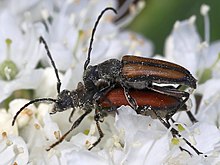
The centrohelids or centroheliozoa are a large group of heliozoan protists. They include both mobile and sessile forms, found in freshwater and marine environments, especially at some depth.
The Philippine hawk-owl is a species complex of owls in the family Strigidae. They are all endemic to the Philippines.

The grey-capped hemispingus is a species of bird in the family Thraupidae that is endemic to Venezuela.

Asaphidion is a Holarctic genus of ground beetle native to Europe, the Near East, North Africa, and North America.
Andamia reyi, the suckerlip blenny, is a species of combtooth blenny found in coral reefs in the Pacific and Indian Oceans. This species reaches a length of 10 centimetres (3.9 in) TL. The specific name honours the collector of the type, the French doctor Paul Rey.
Stictoleptura tripartita is a species of beetle in the family Cerambycidae found in Iran, Syria and Turkey.

Anastrangalia is a genus of beetle in the family Cerambycidae, containing the following species:

Anastrangalia dubia is a species of beetle of family Cerambycidae.
Anastrangalia montana is a species of beetle from family Cerambycidae, that could be found on Crete and Cyprus, in Greece, and in Asian countries like Syria and Turkey. The species, just like their other members of the family, have brown coloured pronotum (males), and black (females).
Anastrangalia laetifica is a species of beetle from family Cerambycidae found in Canada, United States, and Mexico. The males are all black, while the females have 4 black dots on their red coloured elytra. They feed on Frasera albicaulis.
Anastrangalia haldemani is a species of beetle from family Cerambycidae, that could be found in Canada, United States, and Mexico.
Anastrangalia dissimilis is a species of beetle from family Cerambycidae.
Anastrangalia reyi reyi is a subspecies of beetle from family Cerambycidae, that can be found in such European countries as Austria, Belarus, Czech Republic, Finland, France, Germany, Italy, Poland, Slovakia, Sweden, Switzerland, Ukraine, and the Baltic states.

Anastrangalia reyi sequensi is a subspecies of beetle from the family Cerambycidae, that can be found in such Asian countries as China, Japan, Kazakhstan, and Mongolia. The species have brown pronotum.
Anastrangalia dissimilis dissimilis is a species of beetle from family Cerambycidae.
Anastrangalia kasaharai is a species of beetle from family Cerambycidae that is endemic to Japan. The species are either black or red coloured.
Anastrangalia scotodes is a species of beetle from family Cerambycidae. They live especially in Africa.
Anastrangalia sanguinea is a species of beetle from family Cerambycidae.
Anastrangalia rubriola kashmirica is a species of beetle from family Cerambycidae.
The Sulu boobook or Sulu hawk-owl is a species of owl in the family Strigidae. It is endemic to the Sulu Archipelago in the Philippines. It was previously known as a subspecies of the Philippine hawk-owl, but was reclassified in 2012, as voice and other evidence suggested it was a distinct species. It is found in tropical moist lowland forest. It is threatened by habitat loss.






